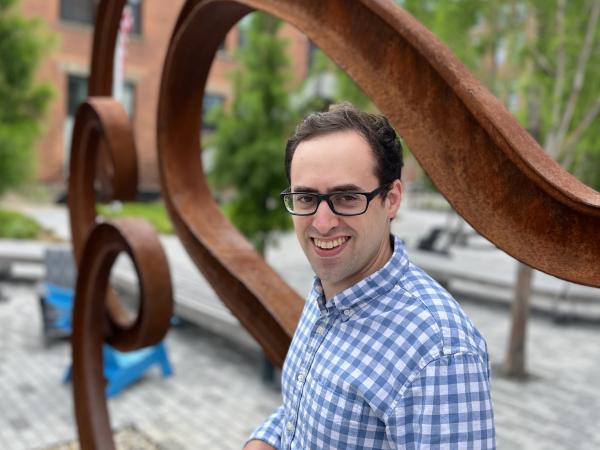
PSFC postdoctoral associate Noah Mandell is developing a new code to model tokamak plasmas.
Photo: Paul Rivenberg
June 28, 2022
Noah Mandell, a Department of Energy (DOE) Oak Ridge Institute for Science and Education (ORISE) postdoctoral fellow at the Plasma Science and Fusion Center (PSFC), is one of two recipients of a 2022 Frederick A. Howes Scholar in Computational Science award. The honor, bestowed each year on one or two recent DOE Computational Science Graduate Fellowship (CSGF) alumni, recognizes outstanding leadership, character and technical achievement in the field of computational science.
Mandell, a 2015-2019 DOE CSGF fellow at Princeton University, received his Ph.D. in 2021. Now at the PSFC he is building on his interest in creating state-of-the-art computational simulations of plasma turbulence in tokamaks, donut-shaped fusion devices that use magnetic fields to keep the hot plasma fuel from damaging the vacuum chamber walls.
As a graduate student, Mandell had helped develop the Gkeyll (pronounced Jekyll) code to model, for the first time, electromagnetic interactions between kinetic plasma turbulence and the confining magnetic field in this outer edge, where the field lines intersect the tokamak walls. At MIT he is now developing a new turbulence code, called GX, to model the hot core of the tokamak. He hopes to use this code to make predictions about the performance of tokamaks, including SPARC, being built by MIT spin-out Commonwealth Fusion Systems.
“How much fusion power SPARC will achieve is something that you could predict from this,” says Mandell. “And so, we'll have GX running in the core and Gkeyll running in the edge; and the idea is to kind of tie them all together. And then you'll cover the whole tokamak.”
Mandell’s approach is focused on making this whole-device modeling framework computationally efficient and tractable. “These are challenging problems with an enormous range of scales in both space and time,” says Mandell, “so we’re using multi-scale algorithms and GPU hardware to target DOE’s exascale computing platforms.” The goal is to use this framework to optimize performance of tokamaks like SPARC by efficiently exploring the properties of various experimental scenarios.
Grateful for the academic experiences that laid the groundwork for his success, Mandell is committed to mentoring students.
“When I was an undergrad at University of Maryland, if I hadn't gotten those opportunities, where would I be?” he says. “And so for me, it's about passing on those same kinds of opportunities and building up the next generation.”
Topics: Magnetic fusion energy, SPARC, Plasma theory & simulation, Plasma turbulence, Nuno Loureiro